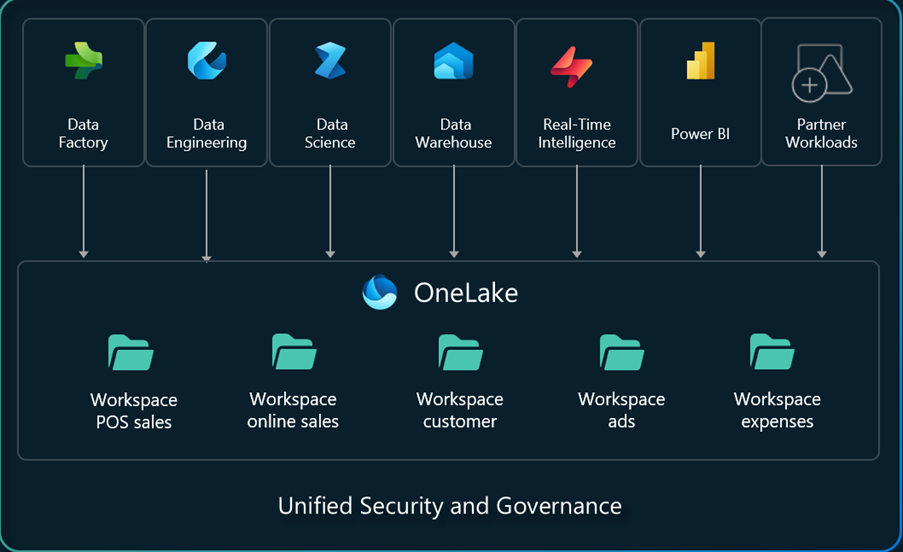In today’s data-driven landscape, trust in data is not a luxury—it’s a necessity. As organisations accelerate their use of AI, analytics, and automation, they need to ensure their data is accessible, secure, and well-managed. This is where data governance plays a critical role.
Microsoft Fabric offers an integrated, end-to-end platform for data and analytics, and its built-in data governance capabilities empower organisations to confidently manage data across departments and workloads. In this blog, we explore what data governance means in the context of Fabric, its real-world impact, and how organisations can use it to build a solid foundation for innovation.
What is Data Governance and Why Does It Matter?
Data governance refers to the overall management of data availability, usability, integrity, and security. It’s not just about compliance, it’s about ensuring that the right people have access to the right data, at the right time, and for the right reasons.
It encompasses policies, guidelines, business processes, user roles, and enforcement measures that define how data is managed across an organisation. Data governance fits into the broader data landscape by overseeing data sources and transformations, ensuring quality and consistency as data flows into analytics and reporting.
Effective governance is built by clearly defining data processes that ensure the availability, integrity, and security of data assets. It plays a critical role in preventing misuse, enhancing operational efficiency, and enabling informed decision-making.
When done well, data governance instils trust in the data being used across the business. Let’s now explore a real-world example to understand how these principles are applied in practice.
A Real-World Example: Finance Reporting Use Case
Let’s consider a finance project where customer accounting information is available in datasets. Data governance policies can ensure the security and proper use of this sensitive data. Key practices include:
- Data classification – identifying sensitive data requiring stringent protection measures. Tagging datasets containing accounting information highlighting their sensitivity.
- Data Encryption – applying encryption rules where sensitive information is stored in datasets and ensuring data is encrypted during transmission to protect it from interception.
- Access control – implementing role-based access controls to ensure only authorised users within a department can access sensitive data. Restricting access to sensitive data ensuring that individual users cannot view or manipulate data directly.
- Compliance and regulatory guidelines – ensure GDPR regulations are met. Conducting regular reviews and updates to Data Governance policies to adapt to evolving regulatory requirements.
By implementing these Data Governance policies, the finance project can securely analyse accounting information without exposing it to unauthorised users. This ensures data confidentiality and compliance with regulatory standards, instilling trust in organisation’s data handling practices.
How Data Governance Supports Responsible AI
Data governance is essential in enabling responsible AI by ensuring high-quality, secure, and ethically managed data throughout the data lifecycle. With quality data, models can help generate accurate, consistent, and complete predictions. Robust security policies help protect sensitive information from unauthorised access and breaches, while adherence to regulations such as GDPR ensures AI systems operate within legal frameworks. Promoting ethical data use further ensures that AI outputs are fair, explainable, and free from bias.
When your AI systems ingest trusted, high-quality data, you have accurate insights for making sound business decisions. All these factors contribute to building trust among stakeholders.
Data Governance in Fabric
Data governance in Microsoft Fabric is a Fabric Administration task that is enforced using one platform, one security and one software. Using built-in configuration tools, information protection, data loss prevention, metadata scanning, endorsement, and certification, can be ensured.

Some key aspects of data governance in Fabric include:
1. Manage Your Data Estate
Fabric’s centralised Admin portal gives administrators control over the entire Fabric estate, including settings for tenants, domains, and workspaces.
2. Secure, Protect, and Comply
Data is secured from unauthorised access, and a compliant platform ensures data stays safe and uncompromised.
3. Encourage Data Discovery, Trust, and Use
Fabric offers integrated features that assist users in locating and utilising dependable, high-quality data.
4. Monitor, Uncover, Get Insights, and Act
Regular auditing of data usage and access helps ensure compliance and security, using Fabric’s built-in monitoring tools.
For a full breakdown of these capabilities and the tools associated with each pillar, you can explore Microsoft’s official guidance here.
Governance in Microsoft Fabric: OneLake Catalog vs. Purview Hub
Microsoft Fabric offers two complementary tools to support data governance: OneLake Catalog and the Microsoft Purview Hub.
OneLake Catalog provides governance capabilities directly within the Fabric platform. It enables users to explore, manage, and monitor Fabric items like workspaces, semantic models, and data stores. Through centralised insights and recommended actions, OneLake helps organisations improve metadata quality, monitor sensitivity labels, and maintain control over their data estate.

Microsoft Purview Hub, on the other hand, connects Fabric to the broader Microsoft Purview ecosystem. It offers built-in reports on data sensitivity, endorsement, and inventory across Fabric, and provides a gateway to enterprise-wide governance tools such as Unified Catalog, Data Loss Prevention, and Information Protection.

While OneLake focuses on native Fabric governance, Purview Hub is ideal for organisations that require cross-platform oversight and compliance capabilities. Used together, they form a powerful foundation for managing data securely and responsibly across your organisation.
Data governance is foundational to building trust in your data, enabling responsible AI, and data compliance across complex data landscapes. Microsoft Fabric’s built-in governance features, supported by OneLake Catalog and the Microsoft Purview Hub, give organisations the control and visibility they need to manage data confidently. Whether you’re managing data across multiple departments or building enterprise-scale AI solutions, these tools help lay the groundwork for secure, scalable, and trusted analytics within Microsoft Fabric.
At Ergo, our deep expertise in Data and AI technologies—including Microsoft Fabric—makes us the perfect partner to help your organisation transform its data capabilities. Whether you’re exploring Fabric in a Day workshops, proof-of-concept projects, or full-scale production implementations, we’re here to guide you toward meaningful, data-driven success.






